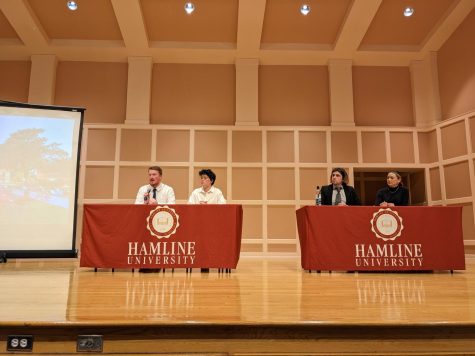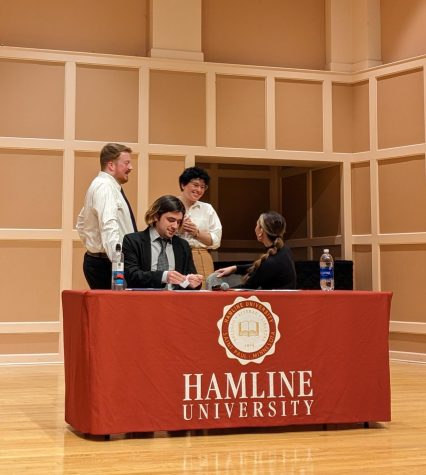HUSC presidential debates; polls open until March 8
March 7, 2023

Almost 40 students gathered in Sundin Hall on Wednesday, March 1 for the HUSC presidential combined informal and formal debate.
The two hour event began with an informal debate with questions from students both in-person and online. After a break, HUSC representatives sophomore Tawny Plentyhorse and senior Tessa Stukey facilitated the formal debate.
Juniors and HUSC executive board members Travis Matthews and Abi Grace Mart are running together against Josh Sedarski and Sophia Hamann, also juniors.
Matthews and Mart have highlighted their three years of combined experience on HUSC.
Although Sedarski is also a current HUSC representative, he and Hamann have emphasized their position as “average” Hamline students. Hamann, a student athlete and non-HUSC member, said that her “outside perspective” as a student athlete is a strength.
“For the community, I’ve been being a TA and being a friendly face around campus and trying to get to know people,” Hamann said.
During the formal debate, Mart argued that experience is a good thing, and that HUSC helps students to be well-rounded. Mart has served as a New Student Mentor (NSM) and has been involved with the Hamline Mock Trial and Theatre programs.
“With those roles, I really learned to engage with the Hamline community, especially within NSM, looking to first-years as our future of this campus and community, and helping them grow,” Mart said.
Mart and Hamann are both running for internal president, a position currently held by junior Maddie Swanson. The internal president runs HUSC’s weekly General Assemblies.
Hamann said that she would use the position to connect with students. Mart hopes to continue making General Assemblies a welcoming, accessible place that advertises resources.
Sedarski and Matthews are competing for external president, a position that primarily works with Hamline administration members and the Board of Trustees. Senior Emily Hilderbrand is the current HUSC external president. Matthews, who works in the Dean of Students’ office, has highlighted his current connections to administration members.
Sedarski, a student researcher for the Physics Department, said he has worked to make research a more accessible process for students.

THE INFORMAL DEBATE
During the informal debate, several students asked candidates about how they would create safe spaces for students of color, in the wake of several hate instances and clashes over inclusion over the past few years.
The first question of the night was from senior Anab Muqtar who asked Sedarski why he went on an “Instagram following spree” of Black students after the art history classroom incident this fall.
Sedarski said that his intent was to connect with students of color on campus.
“My intent, though maybe not impact, was to connect more. I think I might have failed and I need to do better,” he said.
Sedarski said that for future hate incidents, he would like to see more transparency about disciplinary processes, so that the student body is given resources as soon as possible.
Matthews believes that all of campus should be a safe space, but acknowledged that federal law makes disciplinary transparency difficult. As external president, he said his first goal would be to appoint an executive board that represented the diversity of Hamline students, and noted that as white students, he and Mart may have blindspots.
Hamline senior DeAngela Huddleston asked the candidates about campus clashes with administration this year. Sedarski, who played a role in the Sept. 2022 protests against Miller’s comments to student leaders, said that he joined the protests to call for apology and reconciliation. While he still holds frustration, he noted that it was essential to work together with administration, and hopes to have the chance to come together and share his vision.
Sedarski’s running mate, Hamann, noted that she would like to get more students involved when working with administration.
Matthews emphasized that he doesn’t believe it’s appropriate for a HUSC president to “attack” the administration.
“We only have power if we come to the table,” he said.

If elected, he hopes to isolate conflicts to specific directors and work with them one on one, capitalizing on his “pre-built relationships.”
Mart added that as internal president, she would like to bring members of the administration to General Assemblies to directly interact with students.
When asked about supporting student leaders and organizations, Sedarski would like to offer prizes to boost attendance at events and host more shared meals for students.
“I like the idea of coming together over food,” he said.
Hamann, his running mate, said that she would like to conduct surveys to learn about and address student needs.
Matthews acknowledged the gap between commitment and compensation for student org leaders, and said the current HUSC presidents are working on funding.
Mart said she would like to continue using HUSC’s “promotional power” to highlight student orgs.
Accessibility was brought up throughout the informal debate as a primary concern for the Sedarski/Hamann campaign. Sedarski mentioned the lack of ramps near West Hall, a point frequently referenced by students.

THE FORMAL DEBATE
The formal debate began with opening statements from both candidate teams.
Mart and Matthews hope to continue building connections with the Food Resource Center and Women’s Resource Center, based off of Matthews previous experience supporting menstrual hygiene accessibility on campus. They would also like to work with Public Safety to lock and add key card access to all campus buildings
Sedarski and Hamann argued that HUSC members often miss the nuance of being an average student, and therefore, do not accurately represent student needs.
Candidates were asked about how they would support and represent commuter students. All four candidates are commuters, and expressed their commitment to building spaces for commuters to relax and connect with other students.
Sedarski said he would like to make it easier for commuters to get on campus, including better winter parking.
Candidates were also asked about their plans for the HUSC budget. All candidates agreed that the process should be more transparent to students.
Matthews explained that HUSC controls roughly $250,000 each year for initiatives and supporting student organizations.
While all candidates admitted their lack of prior experience with the HUSC budget, Sedarski and Matthews both said that they would work with current presidents Hilderbrand and Swanson to learn.

Although the candidate teams may have different ideas on how to meet student needs, they all agreed that HUSC should empower students and give them a seat at the table.
In his closing statement, Matthews told student voters that it was up to them to decide what values they aligned with.
“At the end of the day, we’re talking about our home,” he said.
Voting for the HUSC spring elections opened on the morning of March 6, for both Co-Presidents and class representatives. Voting can be accessed through a form in a March 6, 8:01 a.m. email from the Student Activities and Leadership Development office.
On Wednesday, March 8, HUSC members will be tabling with free shirts in Anderson until 5 p.m. The online ballot will close that night at 8 p.m.
Candidates can be reached through their Hamline emails or their campaign Instagrams, @sophiaandjoshforhusc and @mart_and_matthews_for_husc
